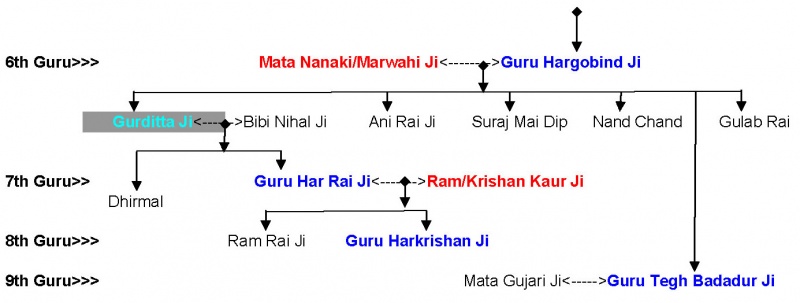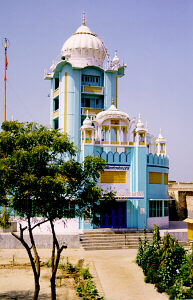Baba Gurditta
| Baba Gurditta | |
| Full Name : | Gurditta |
| Birth : | 1613, Daroli Bhai, Ferozpur |
| Parents : | Guru Hargobind & Mata Ganga |
| Spouse : | Mata Nihal Kaur |
| Children : | Guru Har Rai & Dhir Mall |
| Death : | 1638 |
| Other Info: | |
Baba Gurditta (1613-1638), was the eldest son of the sixth Sikh Guru, Guru Hargobind. He was born on 15 November 1613 to Mata Damodari at Daroli Bhai, District Firozpur in Punjab, India. He was also an elder brother of Guru Tegh Bahadur, the ninth Sikh Guru and the father of Guru Har Rai and Dhir Mall. He was married to Mata Nihal Kaur. He had his training in religious lore and in the martial arts under the supervision of his father.
A beautiful Gurdwara stands at this site called Gurdwara Daroli Bhai, Dist. Firozpur. This Gurdwara marks the birthplace of Baba Gurditta, who was a great saint. The family of Guru Hargobind's wife Mata Damodari still live here and are custodians of some rare personal belongings of the sixth Sikh Guru, Guru Hargobind as well as a handwritten copy of Sri Guru Granth Sahib bearing the personal seal of Guru Gobind Singh. Similarly there is also an another Gurudwara at Anandpur Sahib of Baba Gurdita on a small hill nearby.
He was married on 17 April 1621 to Ananti alias Natti, daughter of Bhai Rama of Batala, an ancient town in Gurdaspur district. According to "Gurbilds Chhevm Pdtshdhi", relations from Darauli, Mandiali, Goindval and Khadur Sahib accompanied the marriage party. Baba Buddha and Bhai Gurdas, however, stayed behind in Amritsar to look after Harimandar Sahib and the Akal Takhat. On returning to Amritsar, the family and the guests offered thanksgiving Ardas and prashad first at Akal Takht and then at Harimandar sahib. From 1626-27, Baba Gurditta lived at Kartarpur in Jalandhar district as directed by his father.
Baba Gurdita, the son of Guru Hargobind along with Bhai Bidhi Chand commanded the defensive action when the Sikhs were besieged in Kartarpur. Guru Sahib himself took part in this action. Painde Khan attacked the Guru with his sword but the Guru, shielding himself, paid him back in the same coin after accepting his challenge. The Guru is said to have wept to see him breathing his last. Baba Gurdita took defensive action when he was attacked in the hand fight by one Asman Khan, his playmate in childhood. The Baba, however, mourned the death of his classmate with the remarks that to kill him was not considered a measure of success, rather it was a disappointment to have been forced by circumstances to kill a friend. Generals Kutab Khan and Kale Khan, both were slain in hand to hand fighting with Guru Hargobind
During this period he founded, under his father`s instructions a habitation, the present Kiratpur Sahib, in the Sivalik foothills. He also look part in the battle at Kartarpur against Painda Khan who was supported by the Mughal garrison commander of Jalandhar. Baba Sri Chand, the aged son of Guru Nanak, appointed Baba Gurditta to succeed him as head of the Udasi sect he had founded. Baba Gurditta proved worthy of the choice, and left a permanent mark on the history of the sect. He is best remembered for having reinvigorated missionary activity to which end he established four dhudns or Udasi preaching centres. Baba Gurditta died at Kiratpur on Chef sudi 10, 1695 Bk, which translates to 15 March 1638. As the legend goes, he had resurrected earlier on that day a cow which he had inadvertently killed while out hunting.
Guru Hargobind, it is said, admonished him for thus displaying a miracle. Baba Gurditta, overtaken by remorse for causing annoyance to his father, quietly retired and betook himself to a lonely place outside Kiratpur where he quit the earthly frame. A dehrd or mausoleum now stands on the spot. Baba Gurditta had two sons Dhir Mall and Har Rai. The latter donned the spiritual mantle of his grandfather whom he succeeded as Guru Har Rai, Nanak VII, in 1644.
Guru Hargobind received the shocking news of the death of his eldest son Baba Gurditta who passed away at age 24, in 1638. Of Baba Gurditta's two sons, the eldest was Har Rai.

See Also
- Mata Nihal Kaur
- Guru family tree
- Guru Har Gobind
- Guru Teg Bahadur
- Sri Chand
- Mata Damodari
- Chakk Nanki
- Dhir Malias
References
- 1. Chhibbar, Kesar SINGH, Bansavalinama Dasan Pdtshahian Kd. Chandigarh, 1972
- 2. Gurbilas Chhevm Patshahi. PATIALA, 1970
- 3. Randhir Singh, Bhai, Udasi Sikhdn di Vithia. Amrilsar, 1972
- 4. Khushwant Singh, A History of the SIKHS, vol. I. Princeton, 1963
- 5. Harbans Singh, The Heritage of the Sikhs. Delhi, 1983

